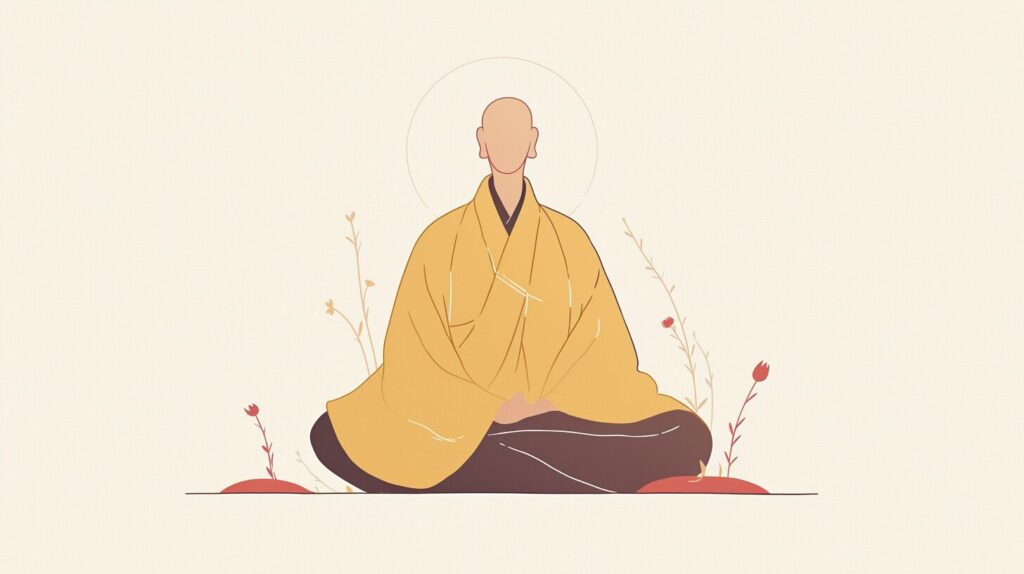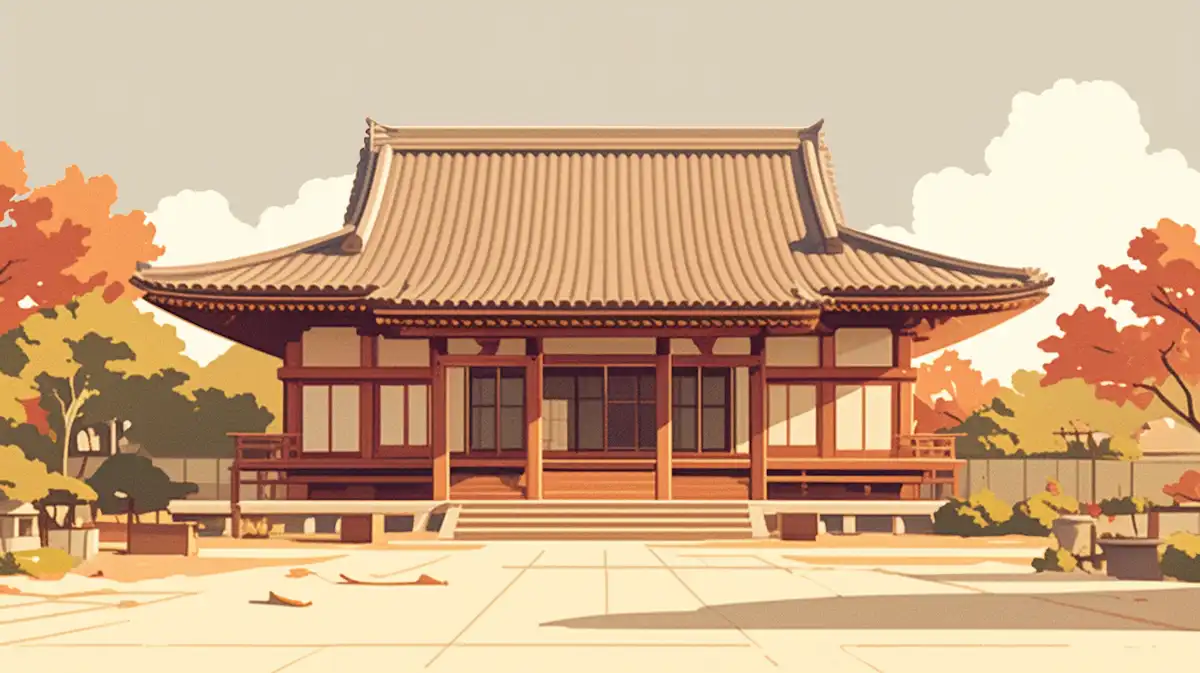唐招提寺を英語で説明・紹介するための基本情報と、英会話に役立つ表現をシンプルでわかりやすい英語で紹介します。
英会話ダイアローグ・概要・10の質問を通して、唐招提寺に関する英語表現を学びます。
英語
英会話ダイアローグを読む前に知っておくと良い前提知識と情報です。
- 唐招提寺の基本情報
- 中国の高僧・鑑真が759年に創建、律宗の総本山
- 「古都奈良の文化財」の一部として1998年に世界遺産登録
- 鑑真について
- 中国・唐の時代の僧侶で、日本に仏教の戒律を伝えるために来日
- 渡航に5回失敗し、6回目で成功。途中で失明
- 唐招提寺を創建し、日本の仏教戒律の発展に貢献
- 唐招提寺の見どころ
- 金堂(国宝): 奈良時代の唯一現存する本堂、盧舎那仏坐像、薬師如来立像、千手観音立像が安置
- 御影堂: 日本最古の肖像彫刻である鑑真和上像(国宝)が安置
- 講堂(国宝): 平城宮から移築された歴史的建築
- 庭園: 四季折々の自然が美しい、特に春と秋が人気
2人が唐招提寺について話しています。
鑑真来日のエピソード、国宝の金堂、鑑真和上像、仏像や庭園などについて話題にしています。
会話 / dialogue

Hey Key, I’ve been hearing a lot about this place called Toshodaiji Temple in Nara. Have you been there?

Oh, yes! I went there last year. It’s an incredible temple with so much history. Why are you interested in it?

Well, I heard it’s connected to a Chinese monk named Ganjin. What’s his story?

Ganjin was an amazing figure. He came to Japan from China in the 8th century to teach Buddhist precepts. It wasn’t easy—he tried to cross the sea five times and even lost his eyesight during the journey.

Five times? That’s unbelievable. So, did he establish the temple himself?

Yes, in 759. Toshodaiji became the center for learning and practicing Buddhist precepts in Japan. Ganjin’s efforts made a huge impact on Japanese Buddhism.

What’s the temple like? Are there any original buildings left?

Absolutely. The Main Hall, or Kondo, is a National Treasure. It’s the only original temple main hall from the Nara period that’s still standing today.

That sounds incredible. What’s inside the Main Hall?

Inside, you’ll find the Rushana Buddha, a Medicine Buddha, and a Thousand-Armed Kannon. All of them are beautifully crafted and hold significant cultural value.

I’m curious—what’s the most famous thing at Toshodaiji?

Probably the statue of Ganjin himself. It’s a dry-lacquered sculpture, and it’s the oldest portrait sculpture in Japan. It’s kept in the Mieido Hall.

That’s impressive. Is it part of the World Heritage sites in Nara?

Yes, it’s included in the UNESCO World Heritage “Historic Monuments of Ancient Nara.” The temple is not just about history—it also symbolizes cultural exchange between China and Japan.

Are there any other highlights I shouldn’t miss?

The Lecture Hall is another treasure. It was originally part of Heijo Palace and was moved to the temple. Also, the seasonal gardens are breathtaking, especially in autumn with the colorful leaves.

It seems like a place with both cultural depth and natural beauty. How about its role today?

It’s still a functioning temple and the center of the Ritsu sect of Buddhism. Monks continue to study and practice Buddhist precepts there.

I’d love to visit. When’s the best time to go?

Anytime is great, but the gardens are especially beautiful in spring and autumn. Plus, the temple has a peaceful atmosphere year-round.

Thanks, Key. This sounds like a must-visit. I’m definitely adding Toshodaiji to my list.

You’ll love it, Mack. It’s a place where you can truly feel the spirit of history and Buddhism.

I can’t wait to experience it. Thanks for the detailed explanation!
概要 / Overview
「唐招提寺」について、理解を深めるための「英語での概要」です。
唐招提寺

Introduction to Toshodaiji Temple
Toshodaiji Temple is a historic Buddhist temple in Nara, Japan. It was built in 759 by Ganjin, a famous Chinese monk. Ganjin came to Japan to teach Buddhist precepts, which are the rules for monks and nuns. Toshodaiji is part of the UNESCO World Heritage “Historic Monuments of Ancient Nara.” The temple is known for its cultural importance and peaceful atmosphere.
The Story of Ganjin
Ganjin was a monk from China who wanted to bring Buddhist teachings to Japan. His journey was not easy. He tried to cross the sea five times, but storms and accidents stopped him. On his sixth attempt, he finally reached Japan in 753. During his journey, Ganjin lost his eyesight but never gave up. He established Toshodaiji Temple to teach Buddhist precepts and left a lasting legacy in Japan.
Historic Buildings
Toshodaiji Temple has several important buildings from the Nara period. The Main Hall (Kondo) is a National Treasure and the only original main hall from that time still standing today. Inside the Kondo, you can see beautiful statues, including the Rushana Buddha, the Medicine Buddha, and the Thousand-Armed Kannon. The Lecture Hall (Kodo) is another treasure. It was originally part of the Heijo Palace and was moved to the temple.
Cultural and Natural Highlights
One of the most famous features of Toshodaiji is the dry-lacquered statue of Ganjin. This statue is Japan’s oldest portrait sculpture and is kept in the Mieido Hall. The temple’s gardens are also a highlight. They are especially beautiful in spring, with fresh greenery, and in autumn, with colorful leaves. Visitors can enjoy the harmony of nature and history.
Toshodaiji Today
Toshodaiji Temple is still an active Buddhist temple. It is the center of the Ritsu sect of Buddhism, and monks study and practice there. The temple is a peaceful place where visitors can learn about history, art, and Buddhism. It is also a symbol of cultural exchange between China and Japan.
Conclusion
Toshodaiji Temple is a unique and inspiring place. Its history, architecture, and connection to Ganjin make it a must-visit destination for anyone interested in Japanese culture and Buddhism.
10の質問 / 10 questions
「唐招提寺」について、理解を深めるための「英語での10の質問」です。
1: What is Toshodaiji Temple?
Toshodaiji Temple is a historic Buddhist temple in Nara, Japan. It was founded in 759 by Ganjin, a Chinese monk, and is known for its cultural importance and peaceful atmosphere.
2: Who was Ganjin?
Ganjin was a Chinese monk who came to Japan in the 8th century to teach Buddhist precepts. He established Toshodaiji Temple after overcoming many difficulties, including losing his eyesight.
3: Why is Toshodaiji Temple famous?
Toshodaiji Temple is famous for its historic architecture, including the Main Hall (Kondo), and for housing the oldest portrait sculpture in Japan, a statue of Ganjin.
4: What is the Main Hall (Kondo)?
The Main Hall is a National Treasure and the only original temple main hall from the Nara period that still exists today. It contains important Buddhist statues like the Rushana Buddha.
5: What can visitors see inside the Main Hall?
Inside the Main Hall, visitors can see the Rushana Buddha, the Medicine Buddha, and the Thousand-Armed Kannon, all of which are beautifully crafted and culturally significant.
6: What is the Lecture Hall (Kodo)?
The Lecture Hall is another important building at Toshodaiji. It was originally part of Heijo Palace and was moved to the temple. It reflects Nara-period architecture.
7: What is special about the statue of Ganjin?
The statue of Ganjin is Japan’s oldest portrait sculpture, made of dry lacquer. It is kept in the Mieido Hall and is a National Treasure.
8: Is Toshodaiji Temple a World Heritage site?
Yes, Toshodaiji Temple is part of the UNESCO World Heritage “Historic Monuments of Ancient Nara,” which was registered in 1998.
9: What are the seasonal highlights at Toshodaiji Temple?
Toshodaiji Temple’s gardens are beautiful throughout the year, especially in spring with fresh greenery and in autumn with colorful leaves.
10: What is Toshodaiji Temple’s role today?
Toshodaiji Temple is still an active Buddhist temple. It is the center of the Ritsu sect of Buddhism, where monks study and practice Buddhist precepts.

和訳付
会話 / dialogue

Hey Key, I’ve been hearing a lot about this place called Toshodaiji Temple in Nara. Have you been there?
ねえキー、奈良にある唐招提寺ってところについてよく聞くんだけど、行ったことある?

Oh, yes! I went there last year. It’s an incredible temple with so much history. Why are you interested in it?
ああ、もちろん!去年行ったよ。歴史がすごく深い素晴らしいお寺だよ。なんで興味があるの?

Well, I heard it’s connected to a Chinese monk named Ganjin. What’s his story?
中国のお坊さん、鑑真と関係があるって聞いたんだけど、どんな人なの?

Ganjin was an amazing figure. He came to Japan from China in the 8th century to teach Buddhist precepts. It wasn’t easy—he tried to cross the sea five times and even lost his eyesight during the journey.
鑑真はすごい人だよ。8世紀に仏教の戒律を教えるために中国から日本に来たんだ。簡単じゃなかったよ。海を渡るのを5回失敗して、その旅の途中で視力も失ったんだ。

Five times? That’s unbelievable. So, did he establish the temple himself?
5回も?信じられない。それで、彼自身がそのお寺を建てたの?

Yes, in 759. Toshodaiji became the center for learning and practicing Buddhist precepts in Japan. Ganjin’s efforts made a huge impact on Japanese Buddhism.
そう、759年にね。唐招提寺は日本で仏教の戒律を学んだり実践する中心になったんだ。鑑真の努力は日本の仏教に大きな影響を与えたんだよ。

What’s the temple like? Are there any original buildings left?
そのお寺ってどんな感じ?元の建物は残ってるの?

Absolutely. The Main Hall, or Kondo, is a National Treasure. It’s the only original temple main hall from the Nara period that’s still standing today.
もちろん。金堂っていう本堂が国宝になってるよ。奈良時代から残ってる唯一の本堂なんだ。

That sounds incredible. What’s inside the Main Hall?
それはすごいね。本堂の中には何があるの?

Inside, you’ll find the Rushana Buddha, a Medicine Buddha, and a Thousand-Armed Kannon. All of them are beautifully crafted and hold significant cultural value.
中には盧舎那仏、薬師如来、千手観音があるんだ。どれも素晴らしい作りで、文化的価値が高いよ。

I’m curious—what’s the most famous thing at Toshodaiji?
興味が湧いてきたよ。唐招提寺で一番有名なものって何?

Probably the statue of Ganjin himself. It’s a dry-lacquered sculpture, and it’s the oldest portrait sculpture in Japan. It’s kept in the Mieido Hall.
おそらく鑑真の像だね。乾漆で作られた彫像で、日本最古の肖像彫刻なんだ。御影堂に安置されているよ。

That’s impressive. Is it part of the World Heritage sites in Nara?
それはすごいね。奈良の世界遺産にも含まれているの?

Yes, it’s included in the UNESCO World Heritage “Historic Monuments of Ancient Nara.” The temple is not just about history—it also symbolizes cultural exchange between China and Japan.
うん、「古都奈良の文化財」の一部として登録されてるよ。このお寺は歴史だけじゃなくて、中国と日本の文化交流の象徴でもあるんだ。

Are there any other highlights I shouldn’t miss?
他に見逃せない見どころはある?

The Lecture Hall is another treasure. It was originally part of Heijo Palace and was moved to the temple. Also, the seasonal gardens are breathtaking, especially in autumn with the colorful leaves.
講堂も貴重だよ。もともとは平城宮の建物で、それを移築したんだ。それに、四季折々の庭園も素晴らしいよ。特に秋の紅葉は見ものだね。

It seems like a place with both cultural depth and natural beauty. How about its role today?
文化的にも自然的にも魅力がある場所だね。今はどんな役割を果たしているの?

It’s still a functioning temple and the center of the Ritsu sect of Buddhism. Monks continue to study and practice Buddhist precepts there.
今でも現役のお寺で、律宗の中心になってるよ。僧侶たちが戒律を学んで実践しているんだ。

I’d love to visit. When’s the best time to go?
行きたくなったよ。いつ行くのがベスト?

Anytime is great, but the gardens are especially beautiful in spring and autumn. Plus, the temple has a peaceful atmosphere year-round.
いつでもいいけど、春と秋の庭園は特に美しいよ。それに、一年中静かで落ち着いた雰囲気があるんだ。

Thanks, Key. This sounds like a must-visit. I’m definitely adding Toshodaiji to my list.
ありがとう、キー。これは絶対行くべきだね。リストに加えるよ。

You’ll love it, Mack. It’s a place where you can truly feel the spirit of history and Buddhism.
きっと気に入るよ、マック。歴史と仏教の精神を本当に感じられる場所だから。

I can’t wait to experience it. Thanks for the detailed explanation!
早く行ってみたいよ。詳しく教えてくれてありがとう!
概要 / Overview
唐招提寺

Introduction to Toshodaiji Temple
Toshodaiji Temple is a historic Buddhist temple in Nara, Japan. It was built in 759 by Ganjin, a famous Chinese monk. Ganjin came to Japan to teach Buddhist precepts, which are the rules for monks and nuns. Toshodaiji is part of the UNESCO World Heritage “Historic Monuments of Ancient Nara.” The temple is known for its cultural importance and peaceful atmosphere.
唐招提寺の紹介
唐招提寺は、日本の奈良にある歴史的な仏教寺院です。759年に有名な中国の僧侶である鑑真によって建立されました。鑑真は、僧侶や尼僧のための戒律を教えるために日本に来ました。唐招提寺はユネスコ世界遺産「古都奈良の文化財」に登録されており、文化的重要性と静かな雰囲気で知られています。
The Story of Ganjin
Ganjin was a monk from China who wanted to bring Buddhist teachings to Japan. His journey was not easy. He tried to cross the sea five times, but storms and accidents stopped him. On his sixth attempt, he finally reached Japan in 753. During his journey, Ganjin lost his eyesight but never gave up. He established Toshodaiji Temple to teach Buddhist precepts and left a lasting legacy in Japan.
鑑真の物語
鑑真は、中国出身の僧侶で、日本に仏教の教えを伝えたいと考えていました。その旅は簡単ではありませんでした。彼は海を5回渡ろうとしましたが、嵐や事故に阻まれました。6回目の挑戦で、ついに753年に日本に到着しました。旅の途中で視力を失いましたが、決して諦めませんでした。鑑真は唐招提寺を建立し、戒律を教えることで日本に長く残る遺産を残しました。
Historic Buildings
Toshodaiji Temple has several important buildings from the Nara period. The Main Hall (Kondo) is a National Treasure and the only original main hall from that time still standing today. Inside the Kondo, you can see beautiful statues, including the Rushana Buddha, the Medicine Buddha, and the Thousand-Armed Kannon. The Lecture Hall (Kodo) is another treasure. It was originally part of the Heijo Palace and was moved to the temple.
歴史的建築物
唐招提寺には奈良時代からの重要な建築物がいくつかあります。金堂は国宝で、奈良時代から現存する唯一の本堂です。金堂の中には、盧舎那仏、薬師如来、千手観音などの美しい仏像があります。講堂もまた貴重な建物で、元々は平城宮の一部で、それが寺に移築されました。
Cultural and Natural Highlights
One of the most famous features of Toshodaiji is the dry-lacquered statue of Ganjin. This statue is Japan’s oldest portrait sculpture and is kept in the Mieido Hall. The temple’s gardens are also a highlight. They are especially beautiful in spring, with fresh greenery, and in autumn, with colorful leaves. Visitors can enjoy the harmony of nature and history.
文化的・自然的な見どころ
唐招提寺で最も有名なものの一つが、乾漆で作られた鑑真の像です。この像は日本最古の肖像彫刻で、御影堂に安置されています。寺の庭園も見どころの一つで、春の新緑や秋の紅葉が特に美しいです。訪れる人々は自然と歴史の調和を楽しむことができます。
Toshodaiji Today
Toshodaiji Temple is still an active Buddhist temple. It is the center of the Ritsu sect of Buddhism, and monks study and practice there. The temple is a peaceful place where visitors can learn about history, art, and Buddhism. It is also a symbol of cultural exchange between China and Japan.
現在の唐招提寺
唐招提寺は現在も現役の仏教寺院です。律宗の中心として機能しており、僧侶たちがそこで学び、修行を続けています。この寺は、訪問者が歴史、芸術、仏教について学べる静かな場所です。また、中国と日本の文化交流の象徴でもあります。
Conclusion
Toshodaiji Temple is a unique and inspiring place. Its history, architecture, and connection to Ganjin make it a must-visit destination for anyone interested in Japanese culture and Buddhism.
結論
唐招提寺は特別で感動的な場所です。その歴史、建築、そして鑑真とのつながりにより、日本文化や仏教に興味のある人には必見の場所です。
10の質問 / 10 questions
1: What is Toshodaiji Temple?
唐招提寺とは何ですか?
Toshodaiji Temple is a historic Buddhist temple in Nara, Japan. It was founded in 759 by Ganjin, a Chinese monk, and is known for its cultural importance and peaceful atmosphere.
唐招提寺は日本の奈良にある歴史的な仏教寺院です。759年に中国の僧侶である鑑真によって建立され、文化的重要性と静かな雰囲気で知られています。
2: Who was Ganjin?
鑑真とは誰ですか?
Ganjin was a Chinese monk who came to Japan in the 8th century to teach Buddhist precepts. He established Toshodaiji Temple after overcoming many difficulties, including losing his eyesight.
鑑真は8世紀に仏教の戒律を教えるために日本に来た中国の僧侶です。視力を失うなどの多くの困難を乗り越えて唐招提寺を建立しました。
3: Why is Toshodaiji Temple famous?
唐招提寺はなぜ有名ですか?
Toshodaiji Temple is famous for its historic architecture, including the Main Hall (Kondo), and for housing the oldest portrait sculpture in Japan, a statue of Ganjin.
唐招提寺は金堂などの歴史的建築物や、日本最古の肖像彫刻である鑑真像を収めていることで有名です。
4: What is the Main Hall (Kondo)?
金堂とは何ですか?
The Main Hall is a National Treasure and the only original temple main hall from the Nara period that still exists today. It contains important Buddhist statues like the Rushana Buddha.
金堂は国宝で、奈良時代から現存する唯一の寺院本堂です。盧舎那仏などの重要な仏像が安置されています。
5: What can visitors see inside the Main Hall?
金堂の中で訪問者は何を見ることができますか?
Inside the Main Hall, visitors can see the Rushana Buddha, the Medicine Buddha, and the Thousand-Armed Kannon, all of which are beautifully crafted and culturally significant.
金堂の中では、盧舎那仏、薬師如来、千手観音を見ることができます。それぞれが美しく作られており、文化的にも重要です。
6: What is the Lecture Hall (Kodo)?
講堂とは何ですか?
The Lecture Hall is another important building at Toshodaiji. It was originally part of Heijo Palace and was moved to the temple. It reflects Nara-period architecture.
講堂は唐招提寺のもう一つの重要な建物です。もともとは平城宮の一部で、寺に移築されました。奈良時代の建築様式を反映しています。
7: What is special about the statue of Ganjin?
鑑真像の特別な点は何ですか?
The statue of Ganjin is Japan’s oldest portrait sculpture, made of dry lacquer. It is kept in the Mieido Hall and is a National Treasure.
鑑真像は乾漆で作られた日本最古の肖像彫刻です。御影堂に安置されており、国宝に指定されています。
8: Is Toshodaiji Temple a World Heritage site?
唐招提寺は世界遺産ですか?
Yes, Toshodaiji Temple is part of the UNESCO World Heritage “Historic Monuments of Ancient Nara,” which was registered in 1998.
はい、唐招提寺は1998年に登録されたユネスコ世界遺産「古都奈良の文化財」の一部です。
9: What are the seasonal highlights at Toshodaiji Temple?
唐招提寺の季節ごとの見どころは何ですか?
Toshodaiji Temple’s gardens are beautiful throughout the year, especially in spring with fresh greenery and in autumn with colorful leaves.
唐招提寺の庭園は一年を通じて美しく、特に春の新緑や秋の紅葉が見どころです。
10: What is Toshodaiji Temple’s role today?
現在の唐招提寺の役割は何ですか?
Toshodaiji Temple is still an active Buddhist temple. It is the center of the Ritsu sect of Buddhism, where monks study and practice Buddhist precepts.
唐招提寺は現在も現役の仏教寺院であり、律宗の中心です。僧侶たちが戒律を学び、修行を行っています。

words & phrases
英会話ダイアローグと関連情報に出てきた単語・フレーズです(例文は各3つ)。

precept : 名詞
意味: 戒律、教訓。A rule or principle that teaches or guides behavior or moral practice.
(仏教における僧侶が守るべき戒律を指す)
例文:
- Buddhist monks follow strict precepts.
「仏教の僧侶は厳しい戒律を守ります。」 - One important precept is to treat others with kindness.
「大切な戒律の一つは他人に親切に接することです。」 - The school has clear precepts about honesty and respect.
「学校には正直さと敬意について明確な規範があります。」
eyesight : 名詞
意味: 視力、目の見える力。The ability to see; vision.
(鑑真が旅の途中で失明し視力を失ったことを表す)
例文:
- His eyesight has weakened over the years.
「彼の視力は年々衰えてきました。」 - Good eyesight is important for driving.
「運転には良い視力が重要です。」 - She went to the doctor to check her eyesight.
「彼女は視力を検査するために医者に行きました。」
establish : 動詞
意味: 設立する、築く。To set up or create something, like an institution or system.
(鑑真が唐招提寺を設立したことを指す)
例文:
- Ganjin established Toshodaiji Temple in 759.
「鑑真は759年に唐招提寺を設立しました。」 - The company was established over 50 years ago.
「その会社は50年以上前に設立されました。」 - They aim to establish a new system for education.
「彼らは新しい教育システムを確立することを目指しています。」
lacquered : 形容詞
意味: 漆塗りの、光沢仕上げの。Coated or finished with lacquer, a shiny protective substance.
(鑑真像が乾漆技法で作られていることを説明)
例文:
- The lacquered statue of Ganjin is a National Treasure.
「漆塗りの鑑真像は国宝です。」 - The table has a beautiful lacquered finish.
「そのテーブルは美しい漆仕上げが施されています。」 - Traditional Japanese crafts often use lacquered wood.
「日本の伝統工芸品は漆塗りの木をよく使用します。」
sculpture : 名詞
意味: 彫刻、彫像。A work of art created by shaping materials like stone, wood, or metal.
(鑑真像が日本最古の肖像彫刻であることを説明)
例文:
- The dry-lacquer sculpture of Ganjin is Japan’s oldest portrait sculpture.
「乾漆の鑑真像は日本最古の肖像彫刻です。」 - She visited a museum with ancient sculptures.
「彼女は古代の彫刻がある博物館を訪れました。」 - The artist spent years creating a large sculpture of a lion.
「その芸術家はライオンの大きな彫刻を作るのに何年も費やしました。」
